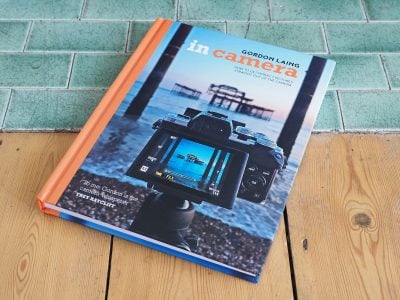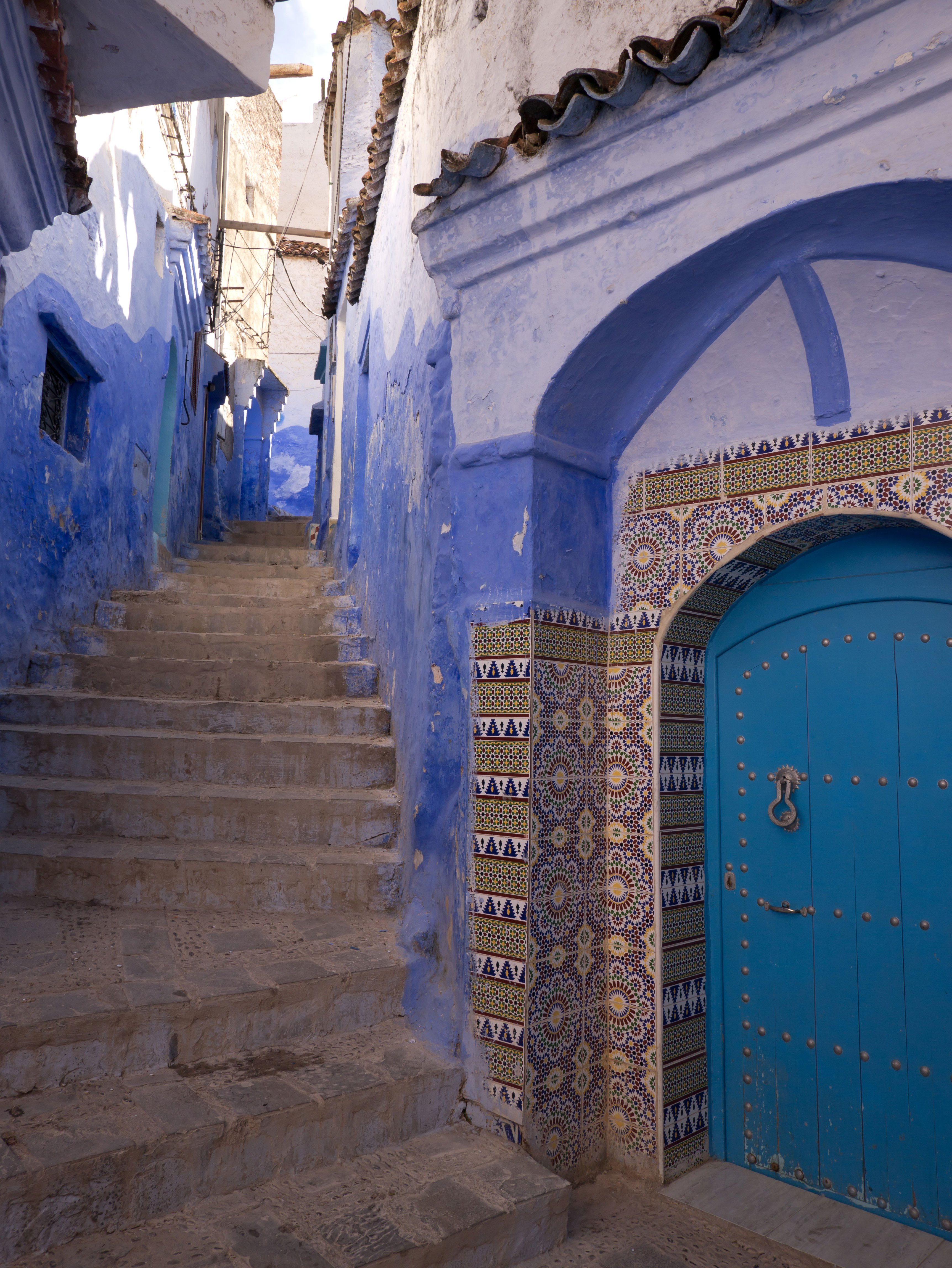
Morocco Tips for Photographers
-
-
Written by Gordon Laing
Morocco has always been high on my list of places to visit and in May 2012 I finally made it a reality with a 12 day family vacation with two young kids – albeit a trip where photography was firmly in mind. Prior to leaving I had two stereotyped images of Morocco as my photographic goal: the winding streets of old Marrakech and the sand dunes of the Sahara Desert. After hitting the road though I quickly realized Morocco had so much more to offer the traveller and photographer. It’s safe, friendly, easy to get around and boasts a surprisingly diverse range of spectacular views.
In just under two weeks we drove ourselves around the country, taking-in some of the best-known sights along with some of those less-visited. By mid-way I was seriously impressed and by the end I’d rank Morocco as one of the highlights in my life of travelling.
But if you’ve never visited, you may understandably not know where to start. I know I didn’t, and it took weeks of research to nail-down an itinerary which included the desired locations and decent accommodation. So on this page I’d like to share our trip with you, the places we visited, the places we stayed, and crucially for the photographers out there, tips on what to take and where to take them!
Note all the photos were taken with a Panasonic GX1 – see my Panasonic GX1 review and the videos below for more details!
Video blogs
I’ll start with two video blogs I made during and after my trip to Morocco. The first was filmed on the edge of the Sahara desert about halfway through my trip and describes some of the highlights so far along with the photography equipment I took with me. The second video looks at the techniques behind my favourite photos in Morocco. This video was filmed in Spain and opens with a brief update of my working holiday experiment where I’m trying to run my business on the road.
Transportation in Morocco
Most tourists spend their first night in Marrakech or Fes, and most likely stay in, or at least spend some time exploring the old town, the Medina. With their narrow twisty streets and chaotic mopeds heading in every direction, you’d be forgiven for not wanting to drive at all. As such it’s not surprising to find many tourists either paying for a guide, a driver or joining a tour when exiting the city.
If that’s your thing, then go for it, but let me assure you, it’s a completely different country outside of those ancient streets. We hired a 2WD manual-transmission car from Sixt in Marrakech and I found it pretty straightforward to get around – certainly if you’ve driven around almost any city in Italy, you’ll be fine in the modern parts of Marrakech or Fes, and if you’ve navigated switchbacks, you’ll have no problem climbing the mountains or gorges. It was even okay for a few minutes of sandy off-road driving to our Kasbah on the edge of the Sahara; there’s really no need for a 4WD unless you’re really seriously going off-road. The car cost just under $300 USD for eight days including a drop-off at a different location; be sure to ask for one with air conditioning and make sure it works before you drive off.
Speaking of navigation the signposts were pretty good, but as a backup we simply cached the areas we were going to drive through on a smartphone prior to departure then used the phone’s GPS to pinpoint our position. To cache the roads, just scroll and zoom around the desired areas in the Maps application at your hotel before setting off. This worked really well on my Samsung Galaxy S and didn’t require a mobile connection on the road either; indeed once my international SIMs were rejected by the local networks, I simply removed them and travelled SIM-free, connecting instead to Wifi at the hotels and riads.
Now don’t get me wrong – there’s no way I was going to drive in the old towns, but there’s no need to. Just park outside them, or arrange your trip so that the driving part occurs between visiting the old towns. That’s what we did with Marrakech at the start and Fes at the end. Sixt also allowed us to collect the car from Marrakech and drop-off at Fes.
On a final note, we flew into Marrakech with EasyJet from London and out of Fes to Barcelona with RyanAir. Both are budget airlines, so be prepared to juggle the contents of your luggage to meet their strict weight limits: a tight 15Kg for check-in bags, but 10Kg of hand luggage per person. This may vary when you travel, so be sure to check before turning up at the airport!
12 days in Morocco: days one and two in Marrakech
On our first day, we flew into Marrakech from London with EasyJet. We wanted an easy arrival, so had booked two nights at the highly rated Riad Limouna, and requested a car to collect us from the airport. As it happened, the airport was very civilized and hassle-free, but when visiting a new country with kids in tow, it’s always nice to know you have transport organized which will take you straight to your accommodation without first visiting fifty carpet shops. We paid 15 Euros for the transfer which is expensive compared to local taxis, but when you’ve just landed in an unfamiliar country with kids in tow, it can be money well-spent until you get your bearings.
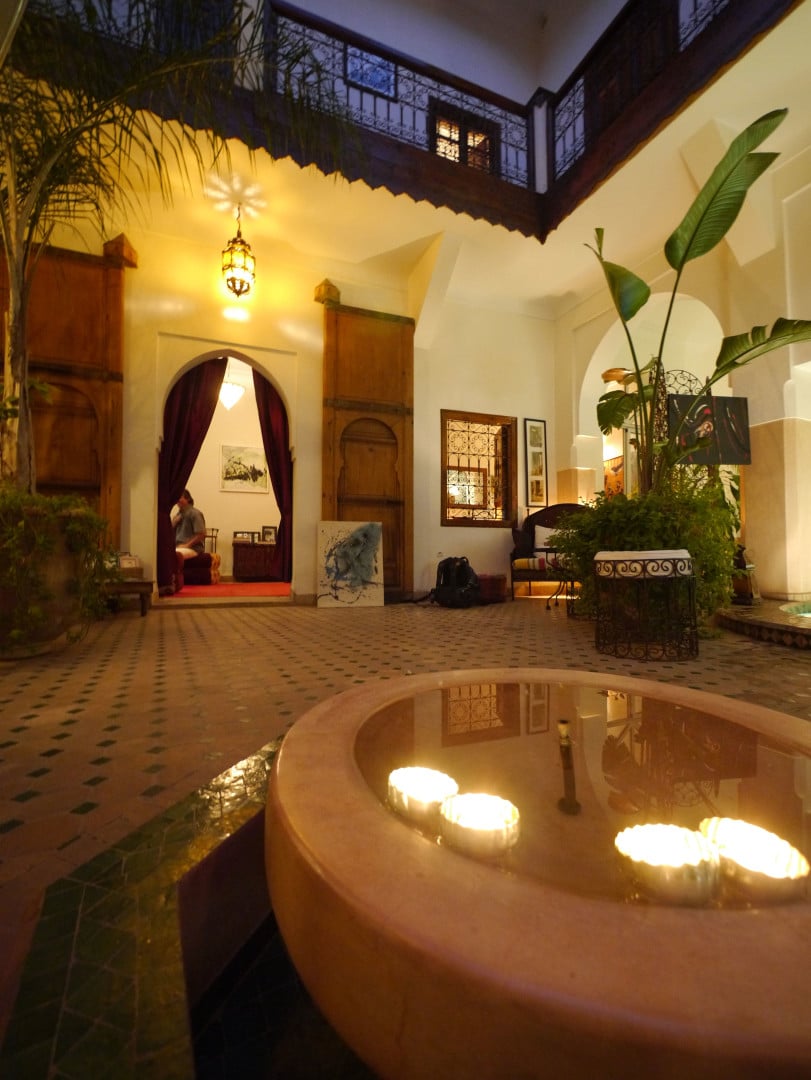
Riad Limouna was everything I wanted from a Riad, with classic styling, but modern flourishes ensuring everything was very comfortable. Manager Antoine did a great job at making us feel at home and answering any questions, while his staff managed the tricky balance of being extremely attentive without ever getting in the way. I generally prefer to eat out, but a late arrival with the kids meant it was easier to dine at the Riad and the home cooked meal at Riad Limouna didn’t disappoint, with the first of many excellent Tagines on our trip.
Our room (with one double, one single and one cot bed) was comfortable and beautifully decorated, although traditional thick walls meant the Wifi signal inevitably became weak in places. Luckily the signal is much stronger in the plush ground floor lounge and dining areas in the centre of the building, plus you’ll enjoy the benefit of round-the-clock fresh mint tea. Which indeed I did. A quick warning though: there’s lots of things to potentially knock over at the Riad, so if you have young or boisterous kids, beware. We paid 90 Euros a night for the room with breakfast, and an additional 50 Euros for two dinners on the first night; like most of the places we stayed at, we were quoted an additional fee for the kids, but after brief negotiation it was almost always waived. So not only would you get beds or cots for them to sleep on, but if you were also eating dinner or breakfast, they were served food too.
Riad Limouna is located on the edge of the Medina just before the streets become really narrow and winding; indeed it’s about as far as you’d really want to drive a car into the old town and there’s parking nearby if you want to leave a car. The best part about the location though is a nearby famous restaurant – not for visiting the restaurant itself, but the fact there’s signs for it everywhere, making it almost impossible to get lost around the winding streets.
As for Marrakech itself, the Medina delivered the experience I wanted with wonderful winding streets and plenty of action and colour without you ever feeling at risk; there was also surprisingly little hassle from street sellers compared to India or parts of Southeast Asia, although maybe they were being respectful of a family with kids.
In terms of photography, I ended up preferring to shoot the streets rather than the actual market stalls, especially after dark – again not due to safety issues, I just preferred the look during the day. I found the best lenses were wide angles to capture street life or macros for details. Dedicated street shooters might prefer a short telephoto, but be aware many of the locals prefer not to be photographed – and they’re not shying away looking for a tip either. I quickly realized while the tourists flock to the old markets, there are many locals who live and work here, and they understandably don’t appreciate a camera in the face.
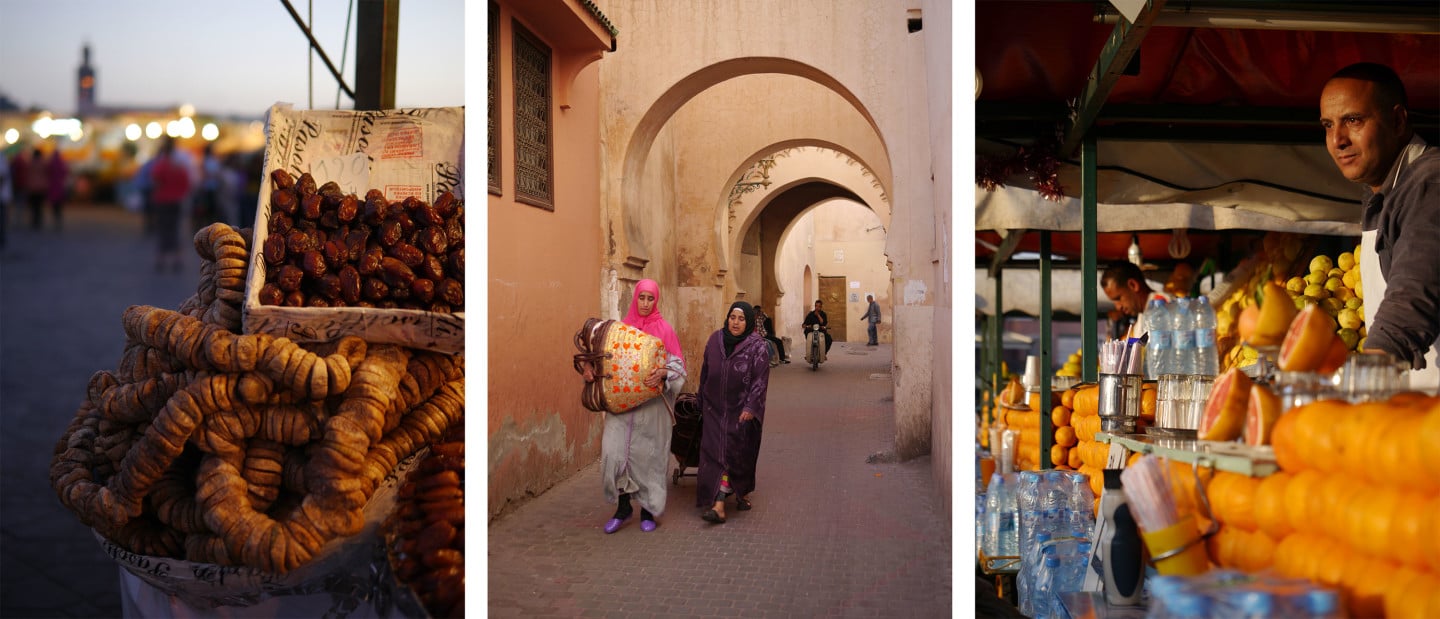
The next day we enjoyed exploring more of the Medina by foot and sampling the various food stalls in the early evening. As always, the canny traveller’s rule applies: aim for stalls with mostly local customers and avoid those with mostly tourists and you won’t go far wrong, although in Marrakech you may subsequently end up dining on sheep’s head. (I resisted that particular delicacy, instead heading for the thick soups and tiny sausages which were excellent).
Day three: over the Atlas Mountains to Ait Benhaddou
The following morning we booked a rental car at Sixt and caught a local cab to the modern part of the town to collect it. If, like us, you’d only been in the Medina so far, it may come as a shock to realise that Marrakech is – of course – a modern city, and getting around poses no problems at all so long as you know how to drive a manual car on the right side of the road and dodge the occasional overly-enthusiastic truck or moped.
We were heading South East over the Atlas Mountains on the N9 towards a small village close to Ouarzate. It’s a great stopping point on your first night out of Marrakech as it’s only a few hours drive over the mountains and gives you time to enjoy the views and arrive before sunset. One quick tip though: on the outskirts of Marrakech you’ll pass Metro, one of the few large supermarkets, so it’s a good idea to stock up on lunchtime snacks and water for the next few days. They also sell Moroccan wine which is well worth trying, but you may need to present your passport at checkout. Sadly there’s no in-store bakery, so grab some bread in the markets before leaving if that’s important to you.
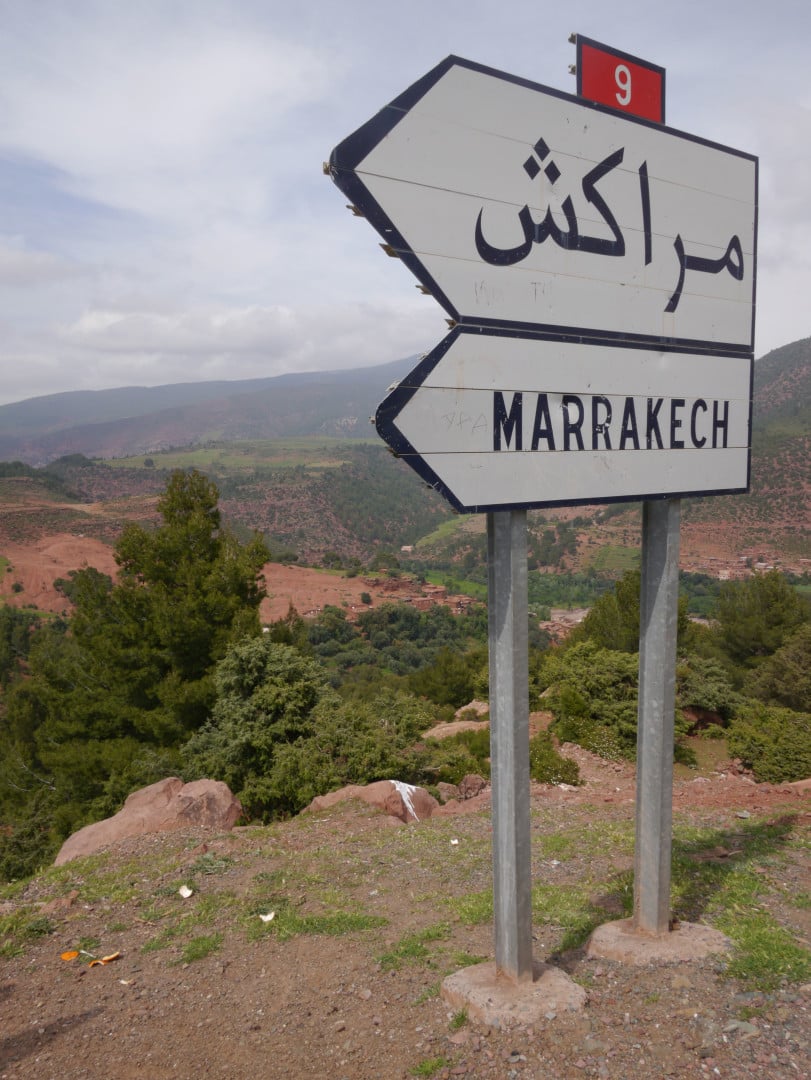
The drive itself over the mountains is fairly easy, although you may get stuck behind some very slow vehicles. There’s quite a few pull-outs where you can grab photos, but be aware that most of the better views across Morocco are also home to people selling various minerals and rocks (or honey in other regions). None gave me a hard time or a hard sell though, so don’t let them put you off from stopping and snapping.
Our accommodation for night three was Auberge Ayouze, in the small village of Asfalou, just a few minutes past the ancient mud-brick fortified village of Ait Benhaddou. Try and get there before sunset as Benhaddou looks best with low sunlight. We arrived in time, but by the time I found a good vantage point, the Sun had already just about touched the horizon. I rose early the next day, but if you’re only there for one night – as I was – you’ll ideally want to maximize your chances.
The age of Ait Benhaddou is unknown, but walking around it you’ll feel transported back to biblical times; indeed many movies have used it as a filming location including The Man who would be King, Jesus of Nazareth, Time Bandits, The Living Daylights, The Last temptation of Christ, Kundun, Gladiator, Alexander and Kingdom of Heaven. It’s an absolutely stunning sight, whether viewed from a distance or exploring on foot.
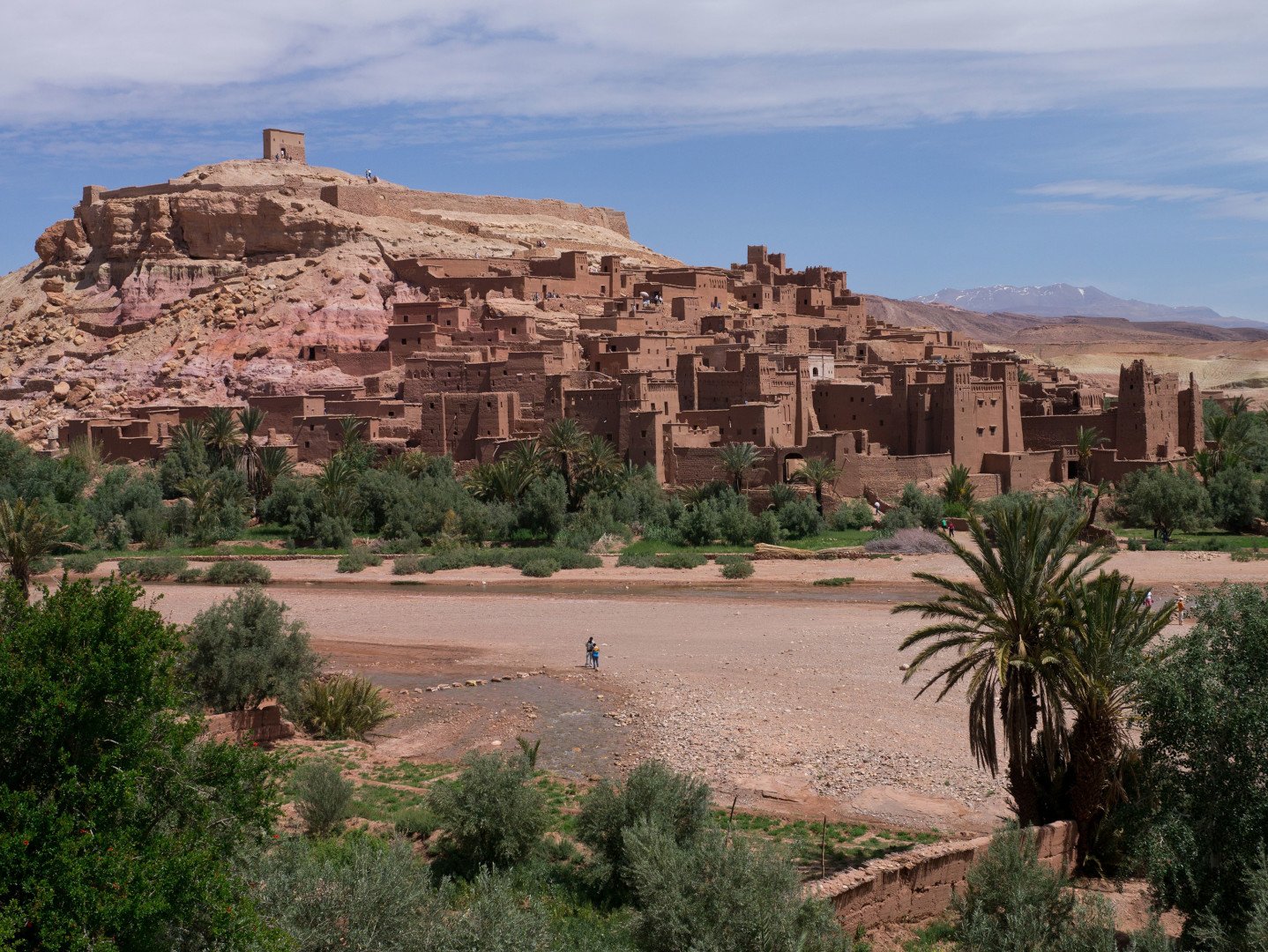
If you want an establishing shot of the ‘town’ you can weave your way through driveways behind the shops from the main road and emerge on a back road with a nice slightly elevated view (albeit with a few trees in the way); to me this looked better than the ground-level view from the main entrance. There’s also a bridge nearby which takes you straight into the buildings without any fee. Don’t get me wrong, I don’t want to avoid entrance fees, it’s just that as far as I understand, there isn’t an official fee and any takings from the main entrance don’t actually go back to support the site. Hopefully as a UNESCO World Heritage site, it’ll gain proper protection and support in the future. But at the time I visited, you could pretty much enter and wander around completely freely.
Suffice it to say the interior streets are stunning and you feel like you’re part of a Biblical epic. Very highly recommended, as was the Auberge Ayouze, a small lodge with nice rooms, friendly staff and a good dinner. Note the Wifi was very slow during my stay though and only available in the common areas like the lounge / dining room, not in the rooms beyond. I certainly wouldn’t pay the extra fee to access it, but then to be fair, that evening they gave me the code for free, so it seems churlish to complain. We paid 610 DM for the room (one double with two singles), which included dinner and breakfast for all of us; (250 for the room, 270 for three dinners and 90 for three breakfasts; our under-two ate free).
Note I’m not normally a fan of eating dinner (or even breakfast) at my lodgings, instead preferring to check out independent cafes, markets and restaurants, but while travelling through Morocco we often found ourselves staying in very small villages – or even in the middle of nowhere – where there literally wasn’t any other choice for meals. Luckily though, almost all the meals we ate at our lodgings were very good – and that’s coming from a demanding foodie too.
That evening some of the staff entertained us with traditional music before they headed out for the night. You’re not expected to tip for this, but you may be expected to join in!
Day 4: Making movies
We spent a very enjoyable morning at Benhaddou, but headed-off around lunchtime as we also wanted to squeeze in a visit to a nearby famous movie studio; indeed Atlas Studios claims to be the biggest in the world. It’s located a few miles outside of Ouarzazate, so you’ll get there fairly quickly from Benhaddou by car.
The studio itself looks like a vast compound from the outside with a gate guarded by enormous Egyptian statues. Inside you’ll find a hotel where you can book a tour (50 DM per adult), and after a short wait, a group of about 15 of us were lead through the main gates.
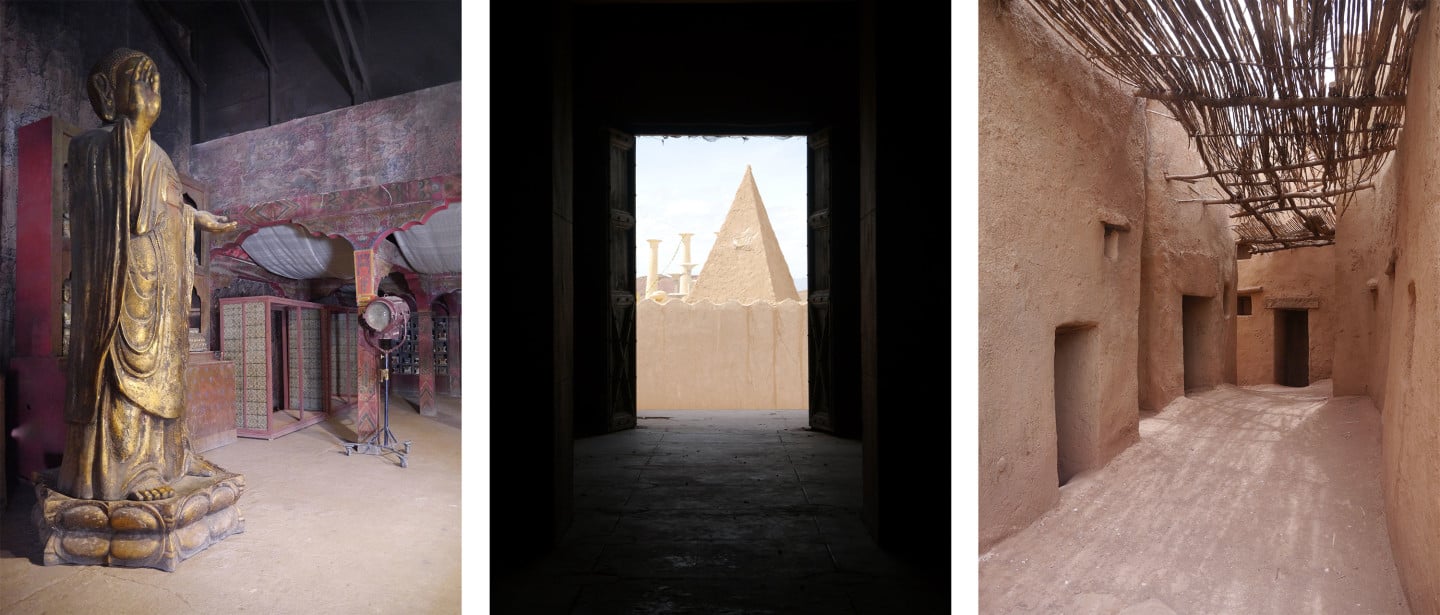
Two things immediately strike you about Atlas Studios: the first is that it is absolutely vast. Your (compulsory) guide will take your group through enormous sets while gesturing at actual castles in the distance which are still part of the complex. The second thing you’ll notice is that everything is pretty run-down and in a state of decay. It feels like it’s been abandoned to the elements, which after filming wraps, I guess it has. There certainly doesn’t seem to be any attempt to preserve it, although it remains great fun to explore the massive site where scenes from Gladiator, Kundun and Kingdom of Heaven were filmed, and marvel at what can be created out of polystyrene. Movie fans will love it, although Universal Studios it ain’t – and despite online reports of some scenes from Star Wars apparently having been filmed nearby, I couldn’t personally find any evidence of them. To be fair to Atlas Studios though, they never claimed they were.
We then headed on to our fourth night’s accommodation: a highly rated Riad / eco lodge named Sawadi, close to the small town of Skoura, itself near to Ouarzazate. This was located a few miles from the main road through Skoura on a track which mid-way crossed a wide dried-up riverbed. It was bumpy going on the 2WD and I’m pleased there was a truck to follow as the route across wasn’t obvious – I’d certainly not recommend attempting this at night. You then have to follow a series of coloured arrows painted on walls, trees and buildings. It felt like a never-ending search, but retracing our steps the next day revealed it wasn’t anywhere near as far as it felt.
The accommodation itself was probably the most up-market of our trip, as was the dinner which was expertly cooked and presented as you’d expect from the discerning French owners; indeed most if not all of the ingredients were grown or sourced from their own gardens. The staff were all nice, but I felt there was a slightly snooty air to some of the other, generally older guests staying there – not all, but some. Well-heeled older couples will feel at home but those with young families may feel they’re disturbing the peace.
I should also mention Sawatdi was the only place we stayed at which wouldn’t negotiate on accommodating and feeding the kids; to be fair it was only a small extra charge, but considering we arrived early evening without a booking and the place was only about half-full, you’d think there’d be more room for negotiation. Then again they know you’ve just driven a road across an unmarked riverbed and are unlikely to turn back at that hour. We paid 1406 DM in total for a room (one double, one sofa bed and one cot) with dinner and breakfast; the room with breakfast was 800 DM plus an extra 100 DM for our ‘kid tax’, while dinner was 181 DM per adult plus 118 for les enfants.
I’d also add the ‘Free Wifi’ extended about three feet from the reception at one end of the complex, rendering it well out of reach from the rooms let alone the common lounge areas – a great shame as they were very plush and inviting. This sadly isn’t uncommon in lodgings around the world, even in the US, but I feel more should be said about it in reviews and any upmarket place advertising Wifi as a feature or benefit should at least ensure it’s available in the common areas as a minimum, and try as hard as possible to extend it into the guest rooms. All it takes for smaller operations is a couple of affordable Wifi repeaters.
Day 5: Hello Gorge-ous
After breakfast we set off from Sawadi and amazingly managed to find our way back across the winding-road and dried up river bed back to Skoura quickly and without incident; we then continued along the N10 towards Morocco’s best-known pair of Gorges: Dades and Todra.
Ideally we wanted to visit both, but time was pressing on and it looked like we’d only manage to catch one while still putting in some miles towards the Sahara before nightfall. We’d read Dades was the least touristy of the pair, so took a gamble on it, enjoying the sight of many old Kasbahs en-route.
We reached the turning for Gorge Dades fairly quickly, but unsurprisingly the drive into the gorge itself was slow and winding. The scenery is however worth the drive, whether it’s the natural beauty of the geology or the settlements en-route. The highlight is when the road climbs from the river to the top of the gorge and back again via a series of dramatic switchbacks. At the very top is a large traditional-looking Kasbah / hotel / café which is a great focal point for an expansive landscape shot of the gorge. There’s a turnout a few hundred meters prior to the building where you can clamber – carefully – onto a ledge for a precipitous view down into the Gorge. I grabbed my tripod and took the opportunity to capture a series of images for a panorama. The lighting was sadly flat at the time I visited, but when you’re driving fair distances between locations every day, you rarely get the chance to visit at the ideal time.
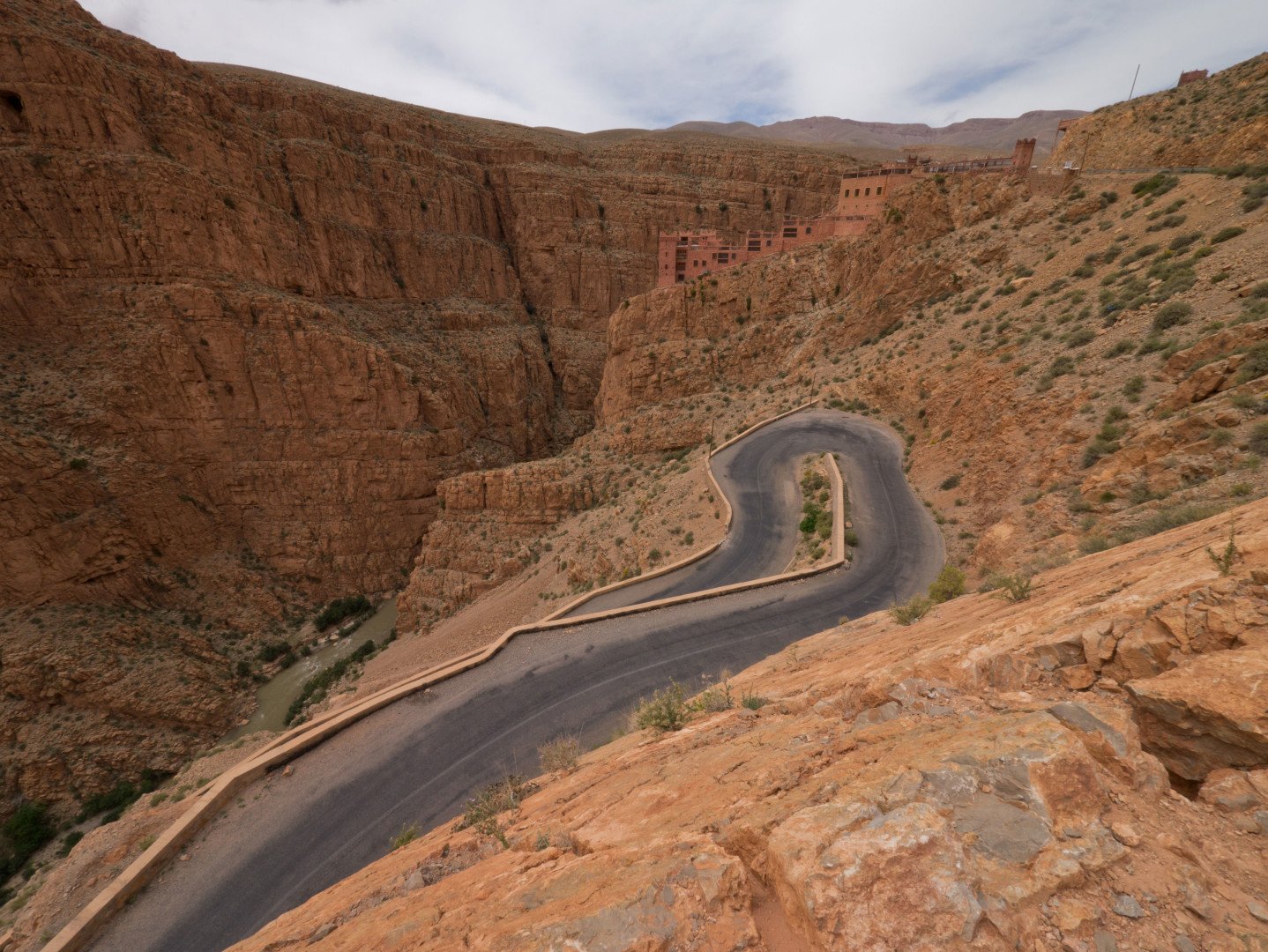
After summiting we drove a little further to a classic canyon view with tall cliff walls and a narrow road through it alongside the river Dades. After taking a few photos we decided to turn back and exit the Gorge as time was getting on and we felt we’d seen the main views. But where to stay that night?
We’d planned on one more night en-route to Merzouga where we’d pre-booked a camel tour for late the following afternoon, but the towns we passed through after exiting Gorge Dades were proving less than inspirational. We had however read glowing reports of Auberge le Festival located 5km within the next Gorge, Todra, and decided to go for it; we didn’t have a booking, but the entrance to the Gorge was littered with promising-looking places to stay so we felt confident of getting a room for the night. It would also of course mean we’d get to see both of Morocco’s famous Gorges.
The reports we’d read were certainly true regarding the Gorges: Todra was much more touristy than Dades, with many more visitor accommodation options not to mention souvenir stalls set up within the most dramatic part of the gorge itself where the vertical walls towered high above the road.
We continued through the Gorge and after a short drive spotted what looked like a small castle in the distance. As we got closer we realized this was Auberge le Festival, a small romantic hotel located deep within the Gorge away from anywhere else. It was a wonderful-looking building in a spectacular location which was pretty accessible but felt like it was in the middle of nowhere. We parked-up and were relieved to find they had a basic room with two beds and shared bathroom facilities available for the night in the main building; it cost 525 DM including dinner and breakfast for all of us.
Auberge le Festival actually has five rooms built into caves along with a lovely little castle alongside the main building. These were booked-up well in advance, but we were happy with our room. There were nice patio areas around the hotel where you could enjoy the scenery along with a pleasant reception / indoor dining area, although the remote location meant Wifi or cellular coverage was out of the question.
The dinner, another Tagine, was nicely prepared, and as with Auberge Ayouze a couple of nights earlier, followed by traditional music played on a variety of bongos; the kids loved dancing to those. Breakfast the following morning was also very good and I should note the only one of the trip which included eggs, served here as an omlette alongside the usual Moroccan breads. Despite not getting to experience the ‘romance’ of a cave room, I loved our stay at Auberge le Festival: a lovely place with good food in a beautiful location. I was really pleased we’d made the effort to drive into Gorges Todra after initially rejecting it in the morning.
Days 6 and 7: Into the Sahara…
We rose early the next day – at least for us – as we anticipated a long drive to Merzouga in order to make our 4:30pm camel tour. But a local guide who was heading the other direction assured me it was more like three hours from our location in the Gorge Todra. He also reckoned the smaller but more direct road to Arfoud was quicker than staying on the N10 via Errachidia before heading down the N13. We’d been wondering about this option ourselves, so were pleased to have local reassurance.
We packed-up, headed off, and about one third of the way reached the turning-off the N10 onto a reassuringly sealed, straight and fast road. As predicted by the guide earlier, we reached the two-thirds mark at Arfoud around two hours after leaving the Gorges Todra and joined the N13 South to Rissani and Merzouga beyond.
Again the journey passed without incident, although as we drew ever closer to Merzouga we couldn’t help but notice what looked like a distant mountain range bathed in the orange light of Sunset. Only it was midday and there were no mountains for miles. Then it dawned on us the orange range was in fact a bank of sand dunes on the edge of the Sahara desert in the distance. Even from some way off, it’s an incredible sight to see, and as we drew ever-closer, sand began to be evident on the side of the road.
As the miles gradually counted down to Merzouga, I began to look out for signs for Auberge du Sud, where we’d pre-booked our overnight camel tour for that afternoon. The signs came much sooner than I’d expected though, before ever reaching Merzouga: bunches of them at the side of the road pointing in all directions out into the sandy wilderness. Then moments later there was ours: an arrow pointing left along a sandy track off the main road.
Until this point I’d been 100% confident in the capabilities of our 2WD hire car, but I’d never anticipated having to drive across the desert. I was also slightly disconcerted by the absence of, well, anything at this point. No buildings, no vehicles, just an empty road in the middle of nowhere with a load of signs pointing 90 degrees to the left into the sandy distance. It’s not the sort of situation you’re that happy about with a young family in tow, but documentation from Auberge du Sud assured us it was all fine and above board so I turned the wheel, put the car into a low gear and drove off into the desert.
The route was thankfully not pure sand, but a washboard track which juddered us into submission regardless of the speed – no option of aquaplaning here. As we bounced along there were regular signs for our accommodation along with others, gradually heading off in different directions. Before long a few large compounds loomed in the distance and we aimed for ours. We arrived at Auberge du Sud almost exactly three hours after leaving Gorges Todra as the local guide had stated, and interestingly never got to see Merzouga.
Auberge du Sud is positioned literally on the edge of the Sahara desert, with the ever-approaching front line of sand regularly damped-down and brushed away just a couple of meters from the front door; it’s a surprisingly effective way to stop the dunes in their tracks, although you get the feeling that left unchecked, they would quickly consume everything in their path.
Like many buildings in the area, the hotel is surrounded by a castle-like wall, with the majority of the rooms positioned around the edges. Most of the middle is occupied by gardens, a pool and the dining areas off the main reception. The reception is manned by an efficient manager and his friendly team, mostly dressed in traditional Berber gear. For the first five minutes it may look like it’s done for the tourist’s benefit, but as soon as you see everyone working on the tours, you realize it’s simply the most practical attire for the environment. Indeed before long you too get into the spirit and have your scarf wrapped-up Berber-style by the patient staff who must tie hundreds a day.
For most of the day, the hotel feels very laid-back and relaxed with most people just chilling out, but during the run-up to a tour, the reception becomes a hive of activity as residents and day-trippers alike get briefed and prepared. This is why people visit or stay at Auberge du Sud: to explore the Erg Chebbi sand dunes, the largest in the region, and there’s no shortage of options for doing it. You can head out on foot, quad bike, 4WD or camel, and choose anything from a brief nose around to a full-on overnight tent experience in the desert.
We really fancied the latter, but were concerned our two and four year old might not cope with the hour-long camel trek. We’d previously expressed our concern while making the booking by email but the manager reassured us they regularly take very young children out. So the four of us waited eagerly in reception with our head scarves tied.
At this point I should note we paid 120 Euros for the camel trek and overnight ‘luxury’ tent and 70 more for a room back at Auberge du Sud the following evening; as before this was for two adults and two kids half-board with dinner and breakfast included (we’d negotiated for the price to include the kids). The reception gave us all plenty of bottled water to drink and take on the trek. The hotel was also happy to accommodate early arrivals and allows you to use the facilities while you wait for tours. Impressively we were also allowed to check into our hotel room the morning after returning from our camel trek.
As our 4pm camel trek departure approached, groups of people were directed to their various modes of transport: some climbed into 4WDs, other mounted camels and a handful sped-off on quad bikes. I assumed we’d also be lead to camels, but instead were taken to 4WDs which drove for about five minutes before reaching another herd of camels waiting for us.
Each one of us were helped onto the camels which much to my relief stood up gently and patiently waited for everyone else to get ready. We had one camel each and took our kids between our legs. Despite my initial concern, I was relieved to discover there’s plenty of room for a child and both of you can grab onto the same set of handlebars strapped onto the surprisingly comfortable saddle. I was also pleased to discover each camel seemed happy to carry a backpack or two, while a couple of additional rider-less camels followed carrying any additional luggage. You won’t need to bring much with you as you’re only away for one night, but us photographers generally have quite a lot of heavy gear and you’ll certainly be able to bring it with you. I reckon a tripod would be no problem too, although I left mine with my larger bags back at Auberge du Sud.
Once everyone was mounted we were lead off into the desert. I counted 19 camels in four groups, most with just one rider, although revealingly no kids other than our own; there were other kids at Auberge du Sud and the overnight camp, although they travelled by 4WD. Let me reassure you though, if your kids are anything like mine, they’ll absolutely love it. Ours had previously experienced nothing more than a five minute ride on a pony, but grinned throughout the entire camel trek. Well, the four year old did anyway, impressively holding on by herself for the whole journey there and back. Our two year old rocked herself to sleep after a few minutes.
And it wasn’t a five minute ride either. I was initially concerned the trek would be over after just ten minutes when I spotted a large tent in the distance shortly after setting off, but we kept riding for well over an hour. I loved every minute of it, and even managed to grab a couple of half-decent photos en-route. Be warned though, the camels are inevitably quite wobbly, so you’ll be snapping one-handed while your other hand grips the bar. I was travelling with a compact Micro Four Thirds kit (a Panasonic GX1 with 14-42mm power zoom, 7-14mm, 25mm and 45mm) and was impressed to discover I could actually squeeze it all into a relatively small bum-bag (fanny pack) for easy access, but you won’t want tot be swapping any lenses en-route, so fit your most flexible. Also don’t underestimate the wobbling from the ride: I needed shutter speeds of at least 1/1000 to ensure a shake-free image, so I shot in Shutter Priority with Auto ISO.
I had no idea about temperature, but by 4pm in May the desert was cooler than you might expect, so I wore my fleece. There was also a slight breeze which blew a little sand around – nothing like a sandstorm, but enough that you’d want to wear sunglasses and protect your gear from the elements. As the GX1 and my lenses weren’t weather-sealed, I kept them inside a plastic bag tucked into my jacket between shots. Indeed when there’s sand in the air, you may prefer to keep your camera safely packed away altogether. I’d met several people who’s photos progressively suffered from more and more out-of-focus sand blobs as their trip went on. Indeed to be really safe I’d recommend using properly weather-sealed equipment or underwater / tough models, or simply keeping your gear packed away until any breeze calms down. I have to say my 14-42mm Power Zoom lens was never quite the same again afterwards.
After an hour or so on the camel, we arrived at our camp and were shown to our tent. We’d booked the Berber option which consisted of a single large gazebo-style tent with four single beds made-up on the floor. These rested on colourful blankets and rugs, but immediately underneath was the sand; thankfully we saw no wildlife in our tent! As we headed out to explore further, I noted the ‘door’ was simply two flaps in the tent wall which didn’t quite join-up. As for the camp itself, I reckon there were around 30 guests when we stayed. In Sahara tour terms this is quite small and exclusive, and was entirely populated by guests and staff from Auberge du Sud.
The best time to shoot the sand dunes is at sunrise and sunset when the shadows are long, but sadly we arrived at our camp just a little too late. That said, the sky was developing some nice colours so we scrambled-up a nearby dune. This is harder than it looks with the soft sand falling away, but our kids managed fine and loved playing in what was essentially an enormous sandpit. At the top I fired-off a few shots of the darkening sky with my ultra-wide zoom. Wide angle lenses may seem the best choice in this environment, but you have to be careful to avoid any footprints or evidence of the camp if you’re after a wilderness shot.
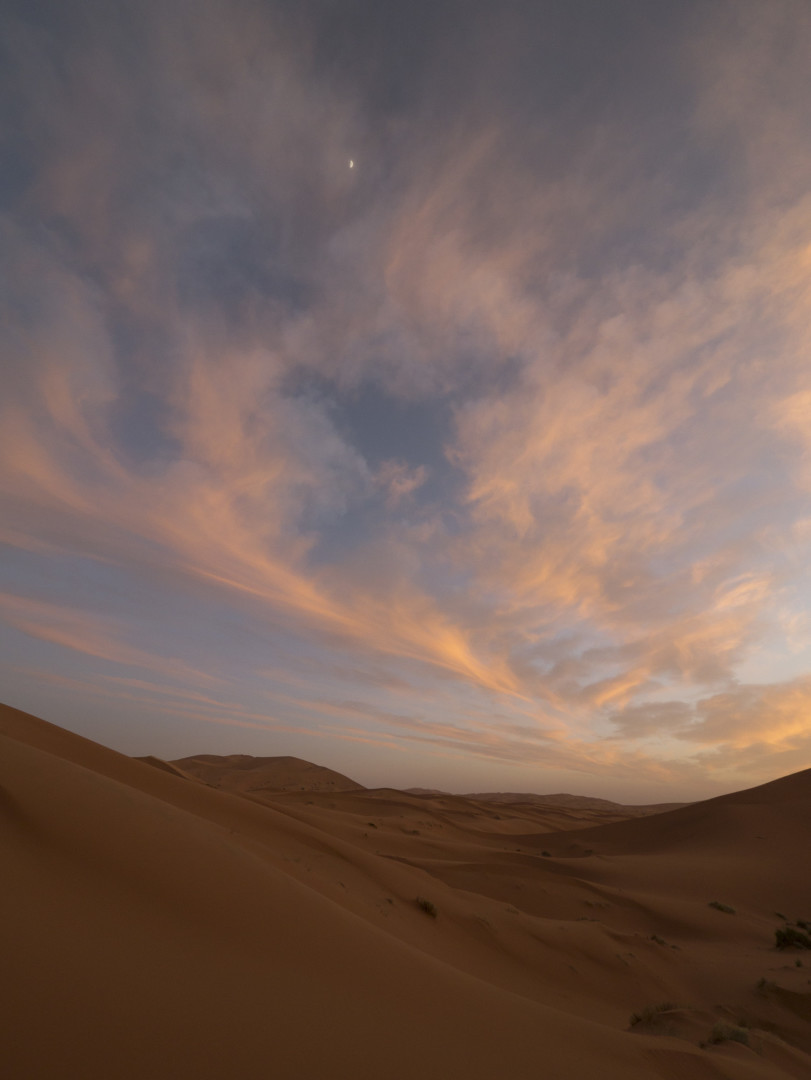
We then slid down the dune on our bums towards the largest tent where dinner was being served. One of the group had brought or borrowed a snowboard, which I’d initially eyed enviously, but his resulting sandy run made me happy I’d not bothered: it was very slow and he managed no more than two of three seconds between each fall. I guess there’s better places to try this, or of course more appropriate equipment.
In the dinner tent we were assigned a table and served not one, but two different tagines, both of which were very tasty indeed. They could really get away with serving you anything out here, but I was impressed by the quality – and the quantity – of the food.
As the evening progressed, our thoughts turned to sleep and the bathroom tent. This small building consisted of five or six proper sit-down toilets, although just one sink meant there was inevitably some congestion as people got ready for bed; my advice would be to bring your toilet bag to dinner and nip-out early or late to avoid the queue.
Back in the tent, the basic beds were comfortable enough, but the non-closing doorway flaps proved to be an issue as the night progressed. Not for marauding desert creatures I’m happy to say, but instead the desert itself. In the middle of the night, the wind picked-up to what sounded like gale-force speed, causing the flaps to, well, flap, noisily. The wind was also surprisingly chilly and anyone unlucky enough to choose the bed closest to the doorway suffered from a constant breeze all night long. Now don’t get me wrong, I’m not one of those people who expects five star luxury in the wilderness, but I feel I should warn you none-the-less that you may not be enjoying much sleep. My family, deeper in the tent were fine, but by the doorway flaps I didn’t have much luck.
We rose early the next morning to catch the sunrise and again scrambled-up the nearest tall dune. This time the lighting conditions were much better, although I became painfully aware of how quickly even a handful of people can cover a dune with footprints. Now of course most people are here for the experience and making footprints in virgin sand is as fun as it is in snow, but it can be a problem for photographers who want to snap-off some pristine sand scenes. Indeed despite there only being about five people up there, I found I couldn’t shoot anything in wide angle without the frame being covered with evidence of people. So I took an alternative approach and fitted a short telephoto lens instead, concentrating on smaller areas which could be framed to avoid any marks. This actually worked better than I hoped and I ended up getting the shots I really wanted including some crisp ridges at sunrise.
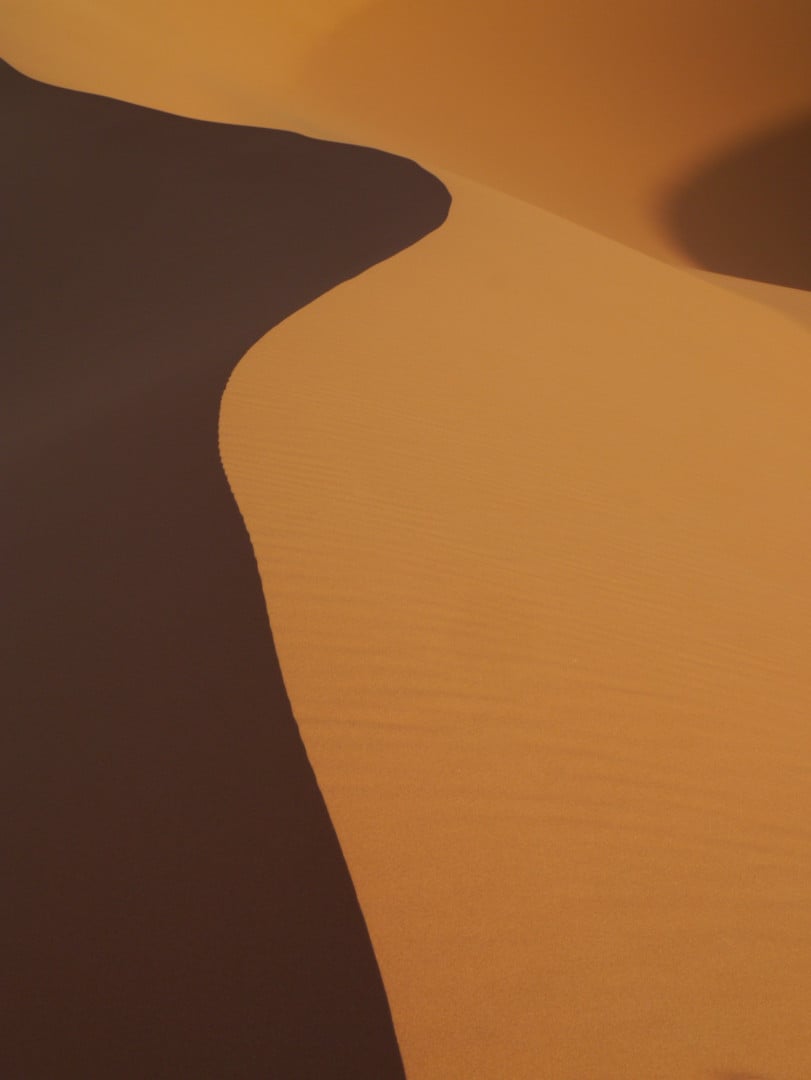
I was also fascinated by the wavy patterns in the sand and tried some macro-photography which again proved a successful technique in the circumstances as it easily allowed me to blur-out any undesirable background detail. I’ve made a video about photographing the sand dunes and other locations in Morocco, so if you’re interested in the imaging side of things, please check it out at the top of this page!
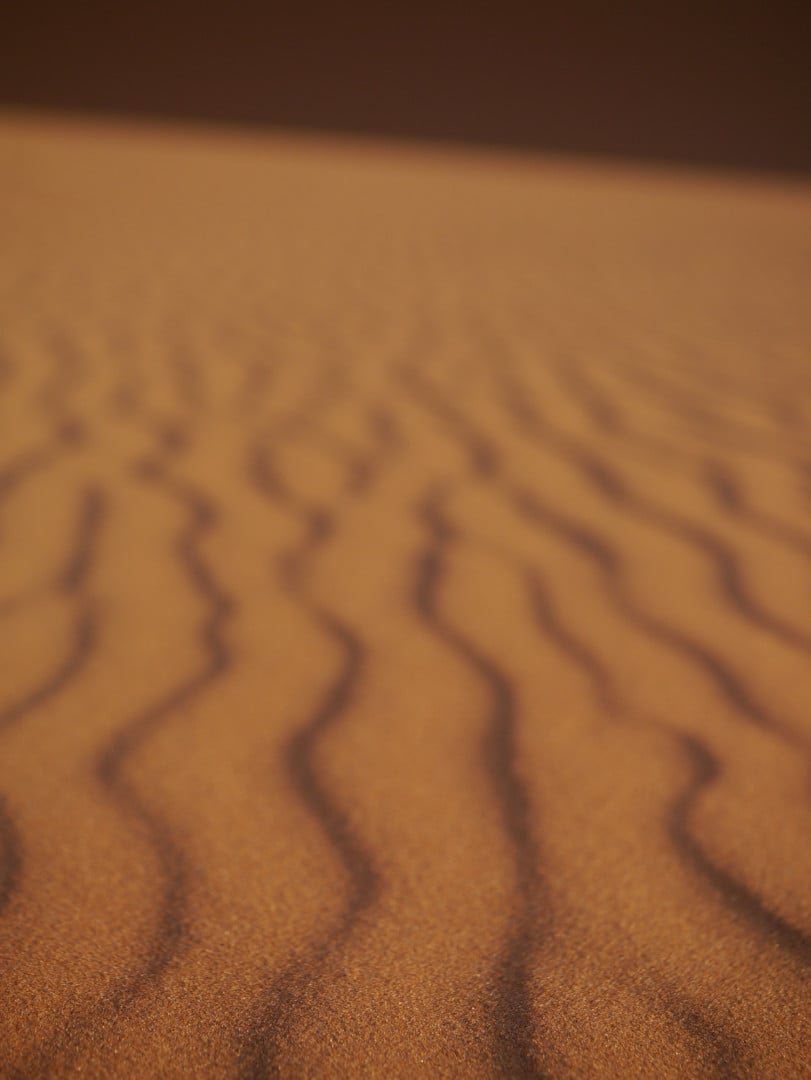
I had plenty of time to enjoy the dunes in the morning before breakfast and the return trip on the camel – and like the journey to the camp, I think I smiled all the way back, and again the kids loved it. What a wonderful shared experience, and one I can absolutely recommend.
We arrived back at Auberge du Sud mid-morning and were served another breakfast which kept us going through the day. As I mentioned earlier, we were also allowed to check into our room for the evening and use the facilities straightaway. The room itself was large and comfortable with one double bed, two singles for the kids and an en-suite toilet; it was a four-person room although we were only charged for two adults as negotiated on the original booking.
After a leisurely day lounging around the hotel and catching up on sleep I decided to head out on foot for some early evening sunset dune shots. The manager recommended a nearby dune which took about half an hour to reach and summit at a fairly leisurely but constant pace. Early on I was intercepted by a Berber guide, but I explained I preferred to do this sort of thing by myself, especially as the route was very easy to follow. He took a bit of persuading, but eventually left me alone after a last ditch attempt to sell me some rocks. Why I’d want to lug around some minerals up a sand dune is beyond me, but there you go.
As before I was hoping for some pristine dunes to photograph, and the short walk to the largest dunes were promisingly untouched, but as I began the climb I noticed more and more people dotted around. By the time I reached the top, the view opened-up to one literally covered with camels, tourists and guides everywhere I looked, all waiting for the sunset. Interestingly I was the only person there without a guide, and most of the tourists and locals alike regarded me with confused expressions as if a short walk by yourself was completely impossible. Many larger groups also looked like they were there to party, which is fine, but no good if you’re after a more peaceful experience. Group tourism politics aside, I had committed to this dune for the approaching sunset and it was now too late to move onto anywhere else, so I settled down for the view and resigned myself to the fact I’d get no photos without scores of people in them.
Luckily I’d grabbed some shots on the way there – plus a few on the way back – but it really did illustrate to me the value of the overnight camel trek. On the trek I’d been slightly disappointed to find more footprints than I’d hoped on the dunes, but it was a world-apart from the dunes within walking distance to the hotels which were literally plagued with tourists. These included people who’d taken shorter evening camel treks, so if you’re looking for a semi-wilderness experience in the desert I’d advise you to take an overnight option to a more distant and semi-exclusive location. I was so pleased the management had persuaded me the kids would be fine as otherwise our only sand dune experience would have been an unpleasant one with the hoards.
I got back to the hotel to find an enormous buffet banquet had been prepared. The hotel dining area was full, so perhaps the magnitude of food only coincided with large group tours, but either way it was extremely impressive and very tasty indeed. Overall I was really impressed with Auberge du Sud, both during the overnight camel trek and back at the hotel itself, and I can highly recommend their service, although again do yourself a favour and go for the overnight trek if you want to experience the desert in any kind of solitude. Of course a higher-end option would be to go on a dedicated photographic tour with 4WD transport to genuinely deserted desert, and this is something I may consider in the future – not for touring the country, but for accessing better sand dunes. Younes Bounhar comes recommended and you can connect with him via his website.
Day 8: An unintentional drive to Fes
The next morning we set-off with the intention to drive to Fes with an overnight stop somewhere en-route, but our proposed towns didn’t work out for various reasons. For example, Midelt was uninspiring, and while Azrou looked nice and was surrounded with monkey-filled national park land, every hotel we checked out had rooms plagued by previous heavy smokers.
We kept pressing on towards Fes and decided to try a small city called Sefrou. We arrived just after sunset after driving for most of the day, but unfortunately had no maps cached of the area, so drove blindly around looking for accommodation. Spotting some signs pointing upwards we headed off the main road along some steep and winding streets in a residential area, only to find a dead-end at the top. I pulled-over and we opened the boot to get some snacks as we planned our next move. Now I won’t go into detail, but lets just say we were pretty fatigued after an all-day drive and you needed the car key to open the boot. Yep, you guessed it, we locked it in there.
Now this was a tricky situation. The front doors were at least unlocked, allowing us to get in and out the car, but the boot was locked with no means to access it from inside or outside the car, and our only key was inside. We were also on top of a hill in a residential area, away from the main road and it was getting late. The only people around were a young couple who looked like they’d prefer not to be disturbed. So I disturbed them.
As luck would have it, they were friendly and spoke English, and the man took it upon himself to help us out, phoning a series of friends who he claimed were mechanics. Within minutes the car was surrounded by six men weighing it up, prodding at various panels and scratching their chins. Now this could have gone one of two ways and had it turned nasty we’d have been stuffed. Although to be fair in order to rob us of any valuables or drive the car off, they’d also face the same problem of actually getting into the boot – so for better or worse we were all in the same boat. Or car.
The car didn’t look particularly well-built, but the boot proved surprisingly hard to access even with brute force and tools. After about an hour they’d managed to dismantle most of the back seat and found a gap just large enough to squeeze a hand into the boot, where amazingly one of them retrieved the keys. Even more impressively they managed to reassemble the car in about five minutes.
I couldn’t be more thankful. We’d thrown ourselves on the mercy of complete strangers in a tricky situation and they’d helped us out without question. I wanted to reward them, but they politely declined and disappeared into the night as fast as they’d first appeared, leaving us with the original young couple. They too refused any kind of reward, but I argued since we’d effectively ruined their night out, I should at least pay for a nice meal. They seemed happy with that and too headed off into the night.
As travellers you often become hardened to many situations and almost feel you have to get around with your game face on. But this experience really restored my faith in human kindness and further enhanced my opinion of Morocco and its people.
Given it was now late at night though we decided to cut our losses and head into Fes and simply stay at the nearest reasonably-priced hotel chain. We found a place next to the Ramada on Sefrou Road which was okay, and had an average pizza at the sprawling restaurant opposite.
Days 9 and 10: Among the blue doors
Our epic drive from the Sahara the day before meant we’d arrived in Fes two days earlier than planned, so the question was whether to hang around or head off to a new location. With two spare nights in the bank we decided to make a move North with Chefchaouen as our bonus destination, and after about three and a half hours on the N4 and N13 we arrived.
Often it’s the unplanned parts of a trip which end up being the most memorable, and Chefchaouen certainly didn’t disappoint. The old town is positioned on the side of a mountain, with its often steep and twisty streets literally enjoying an extra dimension over the historic parts of Fes and Marrakech. As if it needed further enhancement, most of the buildings in the old town are also painted with a blue rinse which is quite visible even on the approach to the city. The result is one of the most picturesque towns I’ve ever visited and one that’s a photographer’s dream. Better still, the laid-back nature of most of the locals means you’ll be able to take photos with the minimum of hassle.
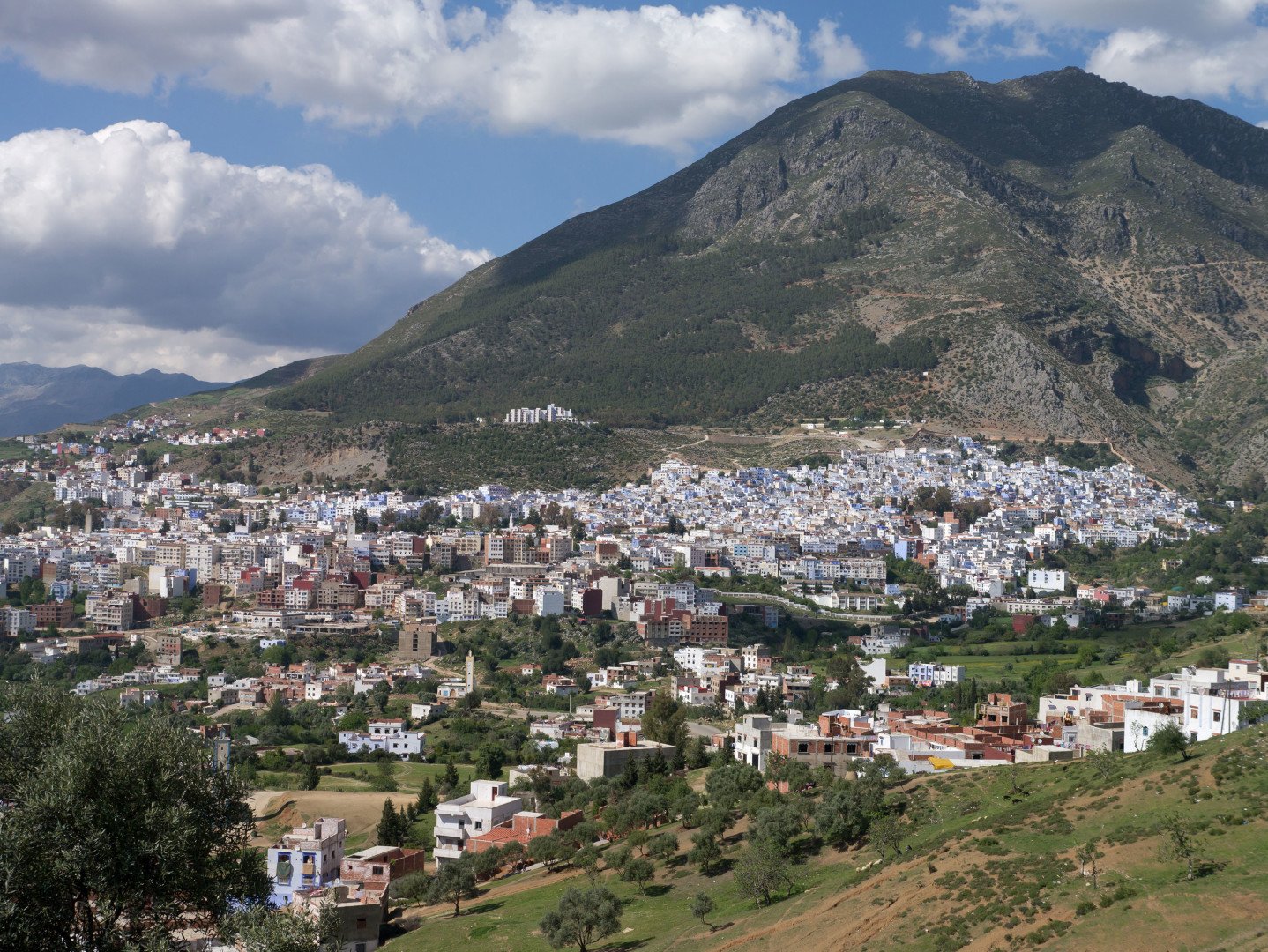
Our arrival though hadn’t gone particularly smoothly. The night before we’d booked the highly rated Casa Perleta (1220 DM for two nights including breakfast) and were told we’d need to park outside the old town. There is in fact a small square outside the Bab Souk gate with parking spaces, but the instant we arrived, we were approached by ‘parking attendants’ who demanded payment staightaway. It turned out they were the ‘officials’ but we didn’t know them from anyone else and didn’t particularly welcome immediate hassle after a long drive. So we unloaded the car, checked into Casa Perleta just two minutes up a cobbled street from the gate, then re-parked the car in a space on nearby Avenue Moulay Ali lbn Rachid opposite a friendly cybercafe. As far as I understand, you can park pretty much anywhere outside the old town so long as you avoid market stalls (or where they’ll setup). We left the car for two nights and it was unharmed apart from a small missing panel which the rental agency didn’t seem bothered about.
Our check-in to Casa Perleta was also a little odd. We’d been impressed with the quick responses from manager Begonia the day before, but had a bad first-impression from the male manager on our arrival. Our room, with two double beds (one on a mezzanine level which charmed our girls), was beautiful, but noisy renovations on the room alongside meant there’d be no chance of any rest during the day. We mentioned this to the manager who basically said if we didn’t like it we could leave – a surprising response from the number one rated hotel on Trip Advsior. But we were tired and didn’t want to move on, so we put it down to a miscommunication. About five minutes later everything began to look up as the same manager brought us mint tea on the lovely balcony overlooking the town. I think he was just having a bad day, and I was also a little moody following the parking attendants. Later we met Begonia, the main manager, who proved to be as charming and helpful as her many positive reviews described and she promised work on the renovations would stop if we needed to return for a daytime rest.
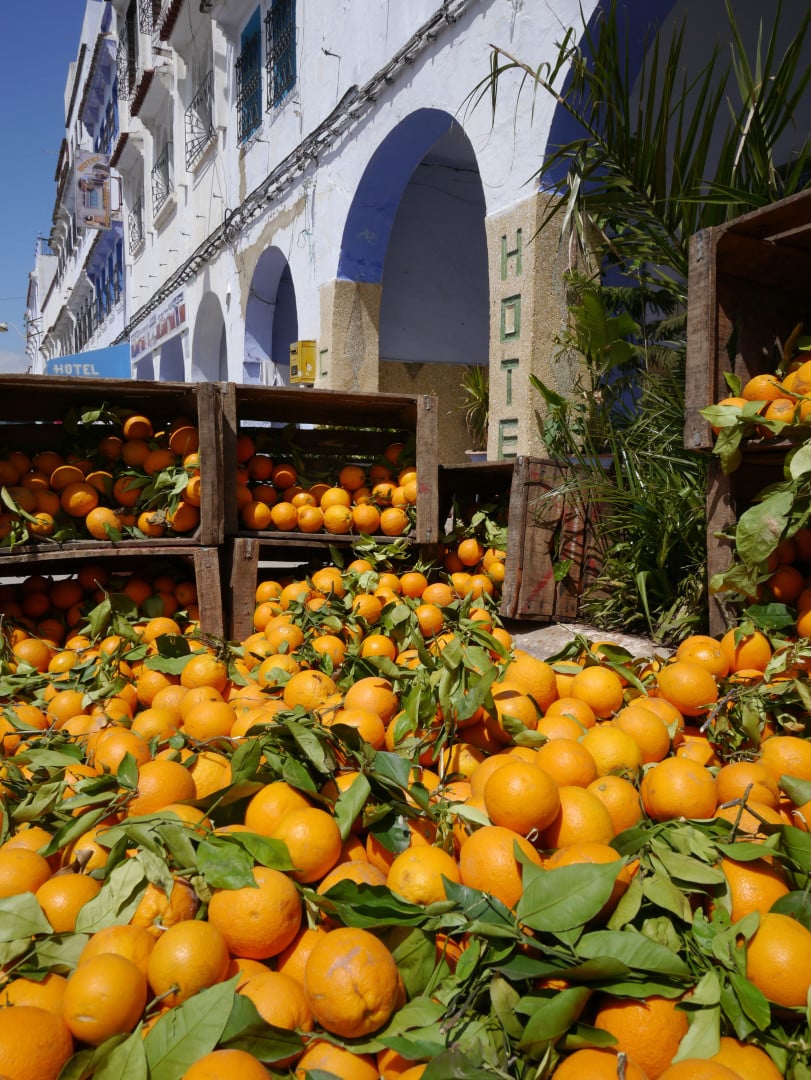
From this point on our two nights in Chefchaouen went very smoothly. I grabbed some nice shots around the old town at different times of day, along with a selection in a colourful food market just outside Bab Souk gate.
On the first evening we enjoyed a nice home-cooked meal at nearby Hotel Dar Gabriel for 165 DM, and on the second evening checked out Tissemlal in Casa Hassan which was quite touristy, but still decent for 183 DM; foodies may note it was featured on a Rick Stein show.
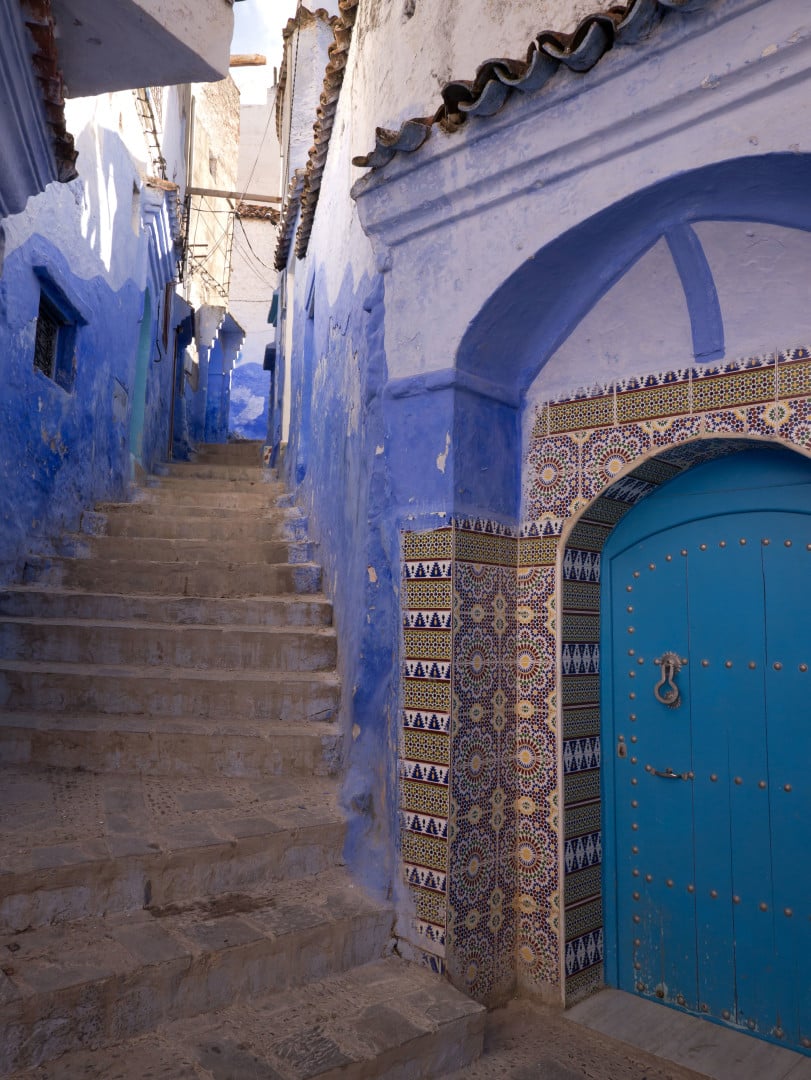
Meanwhile Casa Perleta was a beautiful hotel with lovely rooms and a good breakfast on the upper balcony. The Wifi in the reception managed to just reach our room and again our kids loved staying in the mezzanine level, although any adults thinking of using this upper bed will almost certainly bump their heads on the low ceiling.
Overall Chefchaouen proved to be one of the highlights of what had already become one of my favourite holidays. Yes it’s very touristy in parts, but stay away from the main square and you can quickly find yourself on quiet and charming streets with photo opportunities on every corner.
Day 11: Back to Fes
On our final full day in Morocco we left Chefchaouen and headed back to Fes. We’d arranged to drop the rental car off at the Ramada hotel in Fes where the Sixt representative was waiting for us. After that our only remaining challenge was to find a taxi which could take four people into the Medina. Unfortunately most of the local cabs are only allowed to take a maximum of three passengers, regardless of their age, so rather than split into two groups we decided to book a larger taxi via the front desk of our old hotel next to the Ramada. Yes it was more expensive than two local cabs, but as we were in an unknown city without mobile phones, I wanted to keep us together.
Shortly after, we checked-into Dar Fes Medina, another highly rated Riad which we’d booked a few days earlier. Like many of our earlier hotels, the manager proved to be very friendly, helpful and attentive without ever getting in the way. Our family room with a double bed, single bed, large cot and en-suite bathroom cost 880 DM for one night including breakfast and was large and comfortable, located on the ground floor, just alongside a small communal dining area and lounge. We drank complimentary mint tea with several guests on arrival and late that evening, and used the Wifi which easily extended throughout the common areas and into our room. Despite our room’s proximity to the dining areas, we never heard any noise, although if you intend to head to bed early you may prefer a room on one of the upper floors.
Dar Fes Medina is located just on the edge of the old town which means you can easily access it by car or taxi, but just as easily delve into the narrow, winding market streets. We’d heard Fes can be quite full-on, but had arrived on a Friday when the main market stalls were closed. As such it was actually quite a peaceful and relaxing experience wandering around town, and there were still plenty of street food vendors operating.
We headed straight for the famous Café Clock near to the Bab Boujloud (Blue) gate, a very civilized place on several floors founded by Mike Richardson, formerly of The Ivy and Wolseley restuarants in London; along with all day food, it also hosts popular Moroccan cookery courses. The food, including a camel burger, was very tasty and served by equally friendly staff. Indeed we returned later for another coffee.
Café clock is also situated close to a variety of street food stalls. I opted for a delicious kebab from one of the more popular stalls with a high turnover. As day turned to night, more market stalls opened and the place began to feel busier, but it remained very manageable with the kids. Just outside the gate we also booked a taxi to take us to the airport the next day, thereby avoiding the callout fee into the old town, even if we were on the periphery.
Day 12: Farewell Fes and final thoughts
After a decent breakfast at Dar Fes Medina we packed-up for the last time and waited for our cab to arrive. Unfortunately he didn’t turn up, but luckily I’d grabbed a mobile number for him the night before and a quick call from the hotel manager redirected him to the right address. We then headed to the airport for our flight to Barcelona, the next leg of our bigger trip.
Overall I really enjoyed my trip to Morocco and would rank it as one of my favourite holidays. It’s a very safe and family-friendly destination with an incredible variety of sights and sounds to experience and photograph. I’d gone for the streets of Marrakech and the sand dunes of the Sahara, but also bagged an epic movie studio, a biblical town, two gorges, several mountain ranges and the incredible blue-rinsed medina of Chefchaouen. The overnight camel trek remains the highlight and again I’m so pleased we booked that rather than the shorter options in order to minimize the number of other people around.
I was also impressed with the accommodation and lodgings which almost without exception exceeded my expectations, especially when it came to meals. I normally avoid eating in lodges and hotels, instead preferring to visit local restaurants and street markets but in many cases, our chosen accommodations were remote and the only places to eat. In these situations you’re at their mercy, but in each case the standard of the food was excellent. Sure it was invariably some sort of Tagine, but we never had the same one twice.
So if you’re looking for an exotic but accessible holiday destination, I can highly recommend visiting Morocco! And for anyone planning a long weekend in Marrakech or Fes, I urge you to extend your trip to a week and explore the rest of the country – you won’t be disappointed.
PS – all the photos were taken with a Panasonic GX1 fitted with the Lumix G 7-14mm f4, 25mm f1.4 and 45mm f2.8 Macro lenses – see my videos at the top of this page for more details!
Check prices at Amazon, B&H, Adorama, eBay or Wex. Alternatively get yourself a copy of my In Camera book, an official Cameralabs T-shirt or mug, or treat me to a coffee! Thanks!
